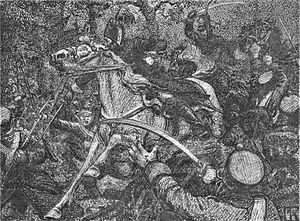Battle of Ruona–Salmi facts for kids
Quick facts for kids Battle of Ruona–Salmi |
|||||||
|---|---|---|---|---|---|---|---|
| Part of the Finnish War | |||||||
 Adlercreutz i striden vid Salmi, by Nils Kreuger |
|||||||
|
|||||||
| Belligerents | |||||||
| Commanders and leaders | |||||||
| Strength | |||||||
| Swedish sources: 4,700–5,000 Russian sources: 7,000 regulars 5,000 militia 30 guns |
Russian sources: 11,000, of which 7,000 engaged 58 guns |
||||||
| Casualties and losses | |||||||
| Swedish sources: 170 killed 400 wounded 110 captured Russian sources: 1,500 killed or wounded |
Russian sources: 845–850 killed, wounded or captured |
||||||
The Battle of Ruona–Salmi, also known as the Battle of Kuortane, was an important fight during the Finnish War. It happened on September 1–2, 1808, in a place called Ruona and Salmi, near Kuortane in Finland. This battle involved soldiers from Sweden and the Russian Empire.
Contents
Who Fought in the Battle?
The Swedish army was led by General Wilhelm Mauritz Klingspor. They had about 4,700 to 5,000 soldiers. Some Russian records say the Swedish army was larger, with 7,000 regular soldiers and 5,000 irregular fighters.
The Russian army was commanded by General Nikolay Kamensky. They had a much larger force of about 11,000 soldiers. This battle was a major event in the war, with a lot of intense cannon fire from both sides.
How the Battle Started
General Kamensky and his Russian troops were moving forward from a place called Alanus. On August 31, they pushed back the Swedish defenses. They then got close to where the Swedish army was set up near Kuortane.
The First Day of Fighting (September 1)
Kamensky planned to attack the Swedish army from different directions. He sent groups of soldiers, called detachments, to go around the sides of the Swedish forces. These detachments were led by Colonel Vlastov and Major general Kazachkovsky.
At the same time, the main Russian attack came from the front. This was led by Colonel Kulnev and later by Major General Raevsky. The fighting on September 1 was very fierce and tough. Both sides fought hard, but the Swedes managed to hold their ground. They could not be forced out of their positions.
The Second Day of Fighting (September 2)
While the front-line fighting continued, the detachments led by Vlastov and Kazachkovsky successfully went around the Swedish army. General Klingspor, the Swedish commander, worried that his army would be completely surrounded. Because of this, he decided to pull his troops back during the night of September 2. They retreated to the village of Salmi.
In the morning, a Russian group of 4,000 soldiers led by Kulnev attacked the Swedish rearguard (the soldiers protecting the back of a retreating army). They defeated them and then attacked the main Swedish army from the front. At the same time, Kazachkovsky's detachment attacked the Swedes from behind.
The Swedish soldiers could not stand up to this double attack. They were chased by Russian hussars (a type of cavalry soldier) and retreated in a disorganized way. They moved northwest towards the town of Vaasa.
What Were the Results?
The Swedes were in a strong defensive position. According to Swedish reports, they lost 170 soldiers killed, 400 wounded, and 110 captured. Many more soldiers also became sick. Russian reports, however, suggest that the Swedes lost up to 1,500 soldiers in total.
The Russians also suffered losses. According to their own records, they had 128 soldiers killed, 648 wounded, and 51 captured (not including 18 officers).
This battle was a very important moment in the Finnish War. It is considered one of the turning points, along with the Battle of Oravais, which happened later.

